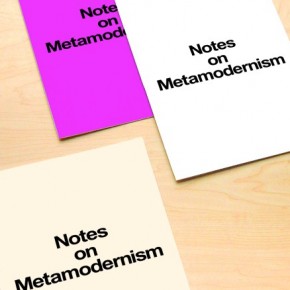
Timotheus Vermeulen and Robin van den Akker‘s foundational essay ‘Notes on metamodernism’ was published in The Journal of Aesthetics and Culture in October 2010. It opens thus:
The ecosystem is severely disrupted, the financial system is increasingly uncontrollable, and the geopolitical structure has recently begun to appear as unstable as it has always been uneven. CEOs and politicians express their “desire for change” at every interview and voice a heartfelt “yes we can” at each photo-op. Planners and architects increasingly replace their blueprints for environments with environmental “greenprints”. And new generations of artists increasingly abandon the aesthetic precepts of deconstruction, parataxis, and pastiche in favor of aesth-ethical notions of reconstruction, myth, and metaxis. These trends and tendencies can no longer be explained in terms of the postmodern. They express a (often guarded) hopefulness and (at times feigned) sincerity that hint at another structure of feeling, intimating another discourse. History, it seems, is moving rapidly beyond its all too hastily proclaimed end.
In this essay, we will outline the contours of this emerging structure of feeling. We will first discuss the debate about the alleged demise of “the” postmodern and the apparent rise of another modernism. We will argue that this modernism is characterized by the oscillation between a typically modern commitment and a markedly postmodern detachment. We will call this structure of feeling metamodernism. According to the Greek–English Lexicon the prefix “meta” refers to such notions as “with”, “between”, and “beyond”. We will use these connotations of “meta” in a similar, yet not indiscriminate fashion. For we contend that metamodernism should be situated epistemologically with (post) modernism, ontologically between (post) modernism, and historically beyond (post) modernism. And finally, we will take a closer look at some tendencies that exemplify the current dominant sensibility, in particular the Romantic turn in contemporary aesthetics.
If you would like to read on, click here.
